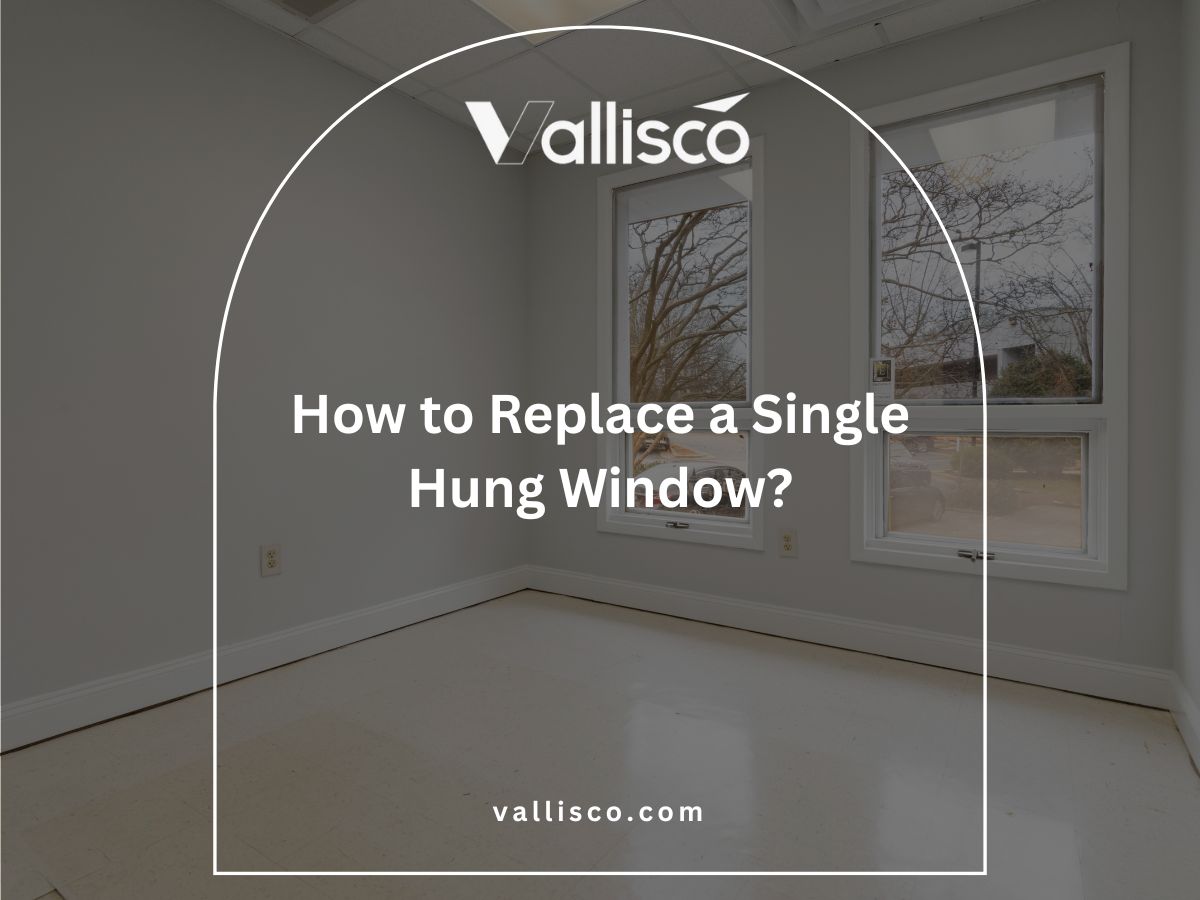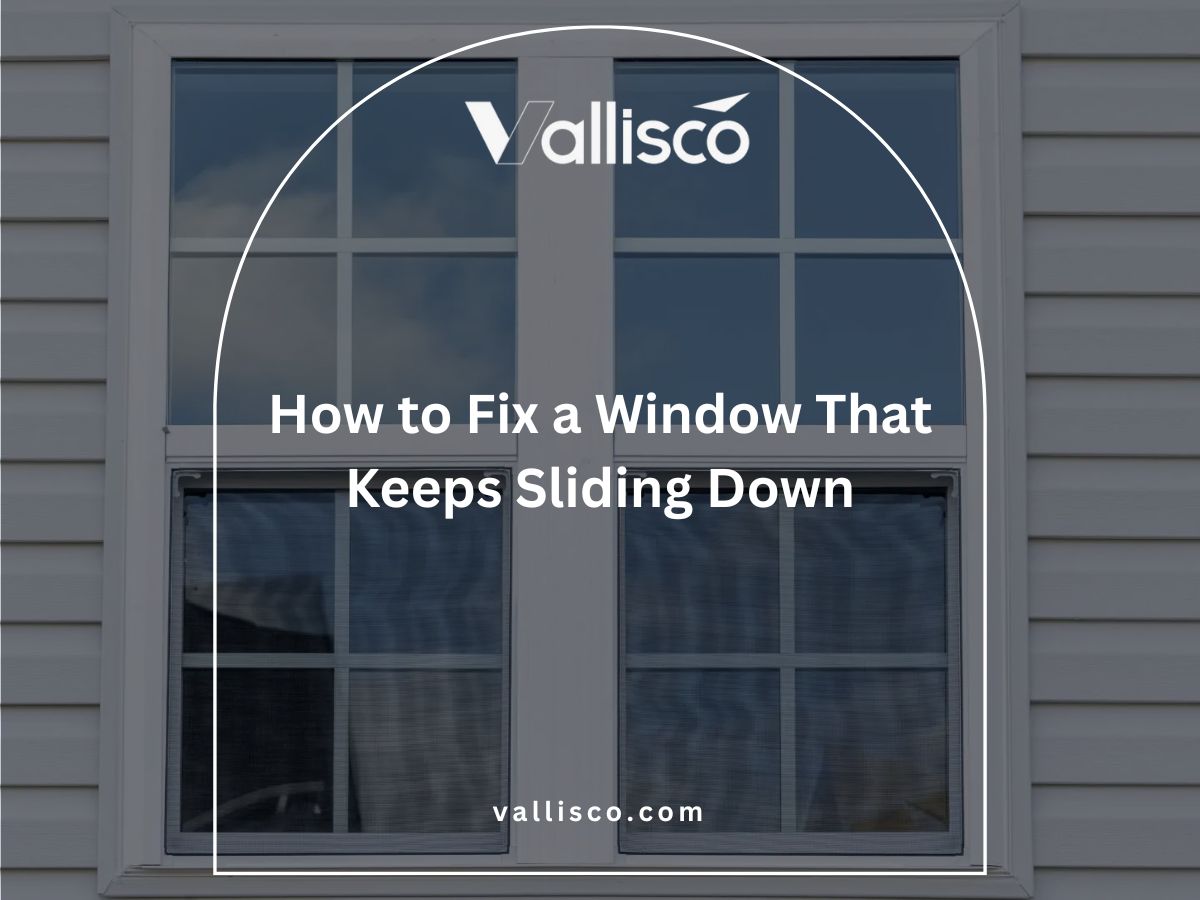I’ve had so many conversations that start the same way:
“My kitchen feels closed in. It’s too dark. Something’s just… off.”
I get it. I’ve walked into kitchens that felt heavy and cramped even when everything was clean and updated. And surprisingly, the fix wasn’t always a big renovation. Sometimes, all it took was adding a bay window.
Over the years, we’ve worked on all kinds of kitchen spaces. And I’ve seen what a bay window can do more light, better air, extra space to sit, or even a place to grow herbs by the sun.
In this article, I’ll share 4 bay window ideas we’ve used in real kitchens. These ideas are simple, useful, and actually work in day-to-day life, not just in pictures.
If you’re wondering what kind of bay window would fit your kitchen, this guide will help you find an option that makes sense and feels right.
So let’s get started!
Quick Comparison Overview
Before we dive into the details, here’s a quick snapshot of the 4 bay window ideas. This gives you a side-by-side view so you can spot what feels right for your kitchen.
| Bay Window Type | Best For | Key Features | Space Needed | Functional Use |
| Breakfast Nook | Cozy seating + light dining | Built-in bench, morning light, comfort-first | Medium to large wall | Relaxation, meals, reading |
| Herb Garden | Growing herbs indoors | Glass shelves, south-facing light, airflow | Small to medium wall | Cooking, fresh ingredients, decor |
| Sink-Centered | Brightening work zones | Casement/awning windows, shallow depth | Small to medium wall | Dishwashing, prep, visual connection |
| Counter Extension | Expanding prep space | Counter pushed into bay, extra surface area | Medium wall above counter | Cooking, serving, storage |
Now that you’ve seen how they compare, let’s explore each one up close starting with the breakfast nook.
1. Breakfast Nook Bay Windows
A breakfast nook with a bay window can completely change the feel of your kitchen. It brings in light, adds warmth, and creates a cozy spot to sit without taking up too much space. I’ve seen it transform kitchens whether in a villa, a rental, or a guesthouse into more inviting places. It’s simple to implement, easy to maintain, and really makes a difference.
General Layout and Placement
- Wall Position: Most breakfast nook bay windows are placed in an exterior wall, often facing the garden or backyard. The window pushes outward, allowing light to come in from different directions, making the space feel more open and airy.
- Seating Setup: You can opt for a built-in bench under the window or a freestanding table and chairs. Some homeowners I’ve worked with also like adding drawers under the bench for extra storage.
Main Function and Benefits
- Extra Light and Space: A bay window brings in light from more than one direction, making the kitchen feel brighter and bigger. I’ve worked on kitchens where this simple change made all the difference, without the need for a full remodel.
- Multipurpose Area: The breakfast nook is more than just a place to eat. One family I worked with mentioned that it quickly became their go-to spot for everything from homework to morning coffee. It’s flexible, and that’s what makes it so valuable.
Recommended Kitchen Types
- L- or U-Shaped Kitchens: If you have a layout where one side opens to the outdoors, this is a great option. The bay window fits naturally, adding light and air without disrupting the flow of space.
- Villas or B&Bs: If you’re working on a property like a villa or guesthouse, a bay window in the kitchen facing a garden gives guests a soft-lit, inviting space to enjoy their morning. It adds a little something special to their experience.
Design Features to Consider
- Storage Benches: A built-in bench with lift-up lids is one of the smartest ways to add storage. I’ve seen this work wonders in kitchens, providing space to store small appliances, placemats, or even pet bowls.
- Durable Materials: Kitchens can get messy, so choosing moisture-resistant materials is key. For high-use areas, window frames like those offered by Vallisco provide durability and efficiency. These materials are designed to stand up to the demands of busy kitchen environments.
- Lighting Options: Add a pendant light above the table or wall sconces on each side. This not only keeps the area functional after dark, but it also adds to the cozy feel.
Installation Tips and Precautions
- Spacing Around Furniture: Be sure to leave at least 36 inches between the table and any nearby counters or cabinets. This gives enough room to move around without bumping into things, keeping the space comfortable.
- Wall and Roof Support: When adding a bay window, it’s important to make sure the wall is strong enough to support the extension. If you’re not sure, don’t hesitate to reach out to a contractor who’s experienced with bay window installations. It’s better to double-check than run into issues later on.
A breakfast nook bay window isn’t just a design feature it’s a practical addition that can make your kitchen feel more open, personal, and warm. Whether you’re working on a home or a commercial space, it’s one of those small changes that can have a big impact.
2. Herb Garden Bay Windows
Adding a herb garden bay window can quietly transform your kitchen. It’s the kind of change that makes a big impact without needing a full remodel. More light, more air, and the simple joy of watching something grow this kind of addition can breathe new life into a kitchen that feels too still or plain.
You don’t need to overhaul the entire space to make this happen. If your kitchen already has a window near the sink or prep counter, you might already have the perfect spot for it. A small adjustment like this can completely change the feel of your kitchen, especially if it’s in need of a touch of life and color.
General Layout and Placement
- Above the Sink or Countertop: A bay window above the kitchen sink fits perfectly. It adds space outward without changing the layout of your kitchen. This is especially useful for smaller kitchens, like in villas or inns, where every inch of space counts.
- Shallow or Medium Depth: Most herb garden bay windows don’t need to be deep. Even a 12 to 18-inch projection brings in plenty of light and fresh air.
- Framed by Upper Cabinets: In some kitchens, the bay window fits between two upper cabinets. This way, you can keep the cabinets in place while still expanding the view and light.
- Greenhouse-Style Glass: Some people opt for a sloped glass roof to capture more light, giving the bay a greenhouse feel without the full structure. It’s a great way to enjoy the benefits of a greenhouse, without the commitment.
Main Function and Benefits
- Daily Access to Fresh Herbs: Having fresh basil, rosemary, chives, or mint right where you cook saves time and makes meals feel fresher. It’s a simple way to always have fresh herbs at your fingertips, right in the kitchen.
- Better Indoor Light: The angled glass lets sunlight pour into the kitchen, brightening up even small or darker spaces. This is especially useful in kitchens that don’t get much natural light.
- Built-in Ventilation: Many herb garden bay windows include casement or awning panels that open slightly to let warm air or cooking smells escape. It’s like built-in ventilation without needing extra fans or vents.
- Soften the Kitchen Look: Adding herbs brings texture and color to your kitchen. It helps balance out the harder surfaces, like stainless steel or tile, making the space feel warmer and more inviting.
Recommended Kitchen Types
- Galley and Narrow Kitchens: This window works well in smaller kitchens where every inch of space matters. It doesn’t take up any floor space but adds light and character.
- Villas with Outdoor Views: If your kitchen overlooks a garden or yard, a herb garden bay window can act as a visual extension of that space. It connects the indoor and outdoor areas without needing a door.
- Greenhouse Kitchens or Passive Designs: For homes designed to maximize natural light and air, adding a herb garden bay window is a natural fit. It complements the overall design and adds that extra touch.
- Short-Term Rental Properties: In B&Bs or inns, small touches like living herbs or open windows leave a lasting impression on guests. Guests often appreciate these small, thoughtful details.
Design Features to Consider
- Built-in Plant Shelves: Installing 1 to 2 small glass shelves inside the bay allows for growing multiple herbs. This keeps everything organized without blocking the view.
- Moisture-Resistant Materials: Aluminum or composite frames are great choices, as they won’t rot in the humid kitchen environment. This is important for areas where moisture is consistently present.
- Sunlight Control: If your bay window faces strong sunlight, adding a mesh or roller blind can help. Some herbs prefer shade during peak sunlight hours.
- Drainage Trays: Be sure to use trays under each pot to catch excess water. This keeps the sill clean and prevents potential damage to the window trim.
- Layered Display: Combine taller herbs like rosemary with trailing herbs like oregano for a natural, full look. This gives the bay a lively appearance without feeling cluttered.
Installation Tips and Precautions
- Frame Strength: Even shallow bay windows add weight to the wall. Make sure the framing is secure so it won’t shift over time. This is especially important for older buildings or homes that have been through some wear and tear.
- Access for Watering: Keep the shelves reachable for easy watering. You’ll need to water the herbs regularly, so having them within easy reach makes that process much simpler.
- Seal the Base: Install a water-tight sill under all the plant pots to prevent moisture from seeping into the trim and causing long-term damage.
- Air Circulation: On warm days, open the side panels slightly to keep the air moving. This helps reduce mildew and condensation, especially when growing a lot of herbs.
A herb garden bay window isn’t just a design choice it’s a living part of your kitchen. It adds something fresh, green, and functional, making the space not only more attractive but also more practical. Whether you’re a homeowner or managing a short-term rental property, this simple addition brings life and vibrancy to any kitchen.
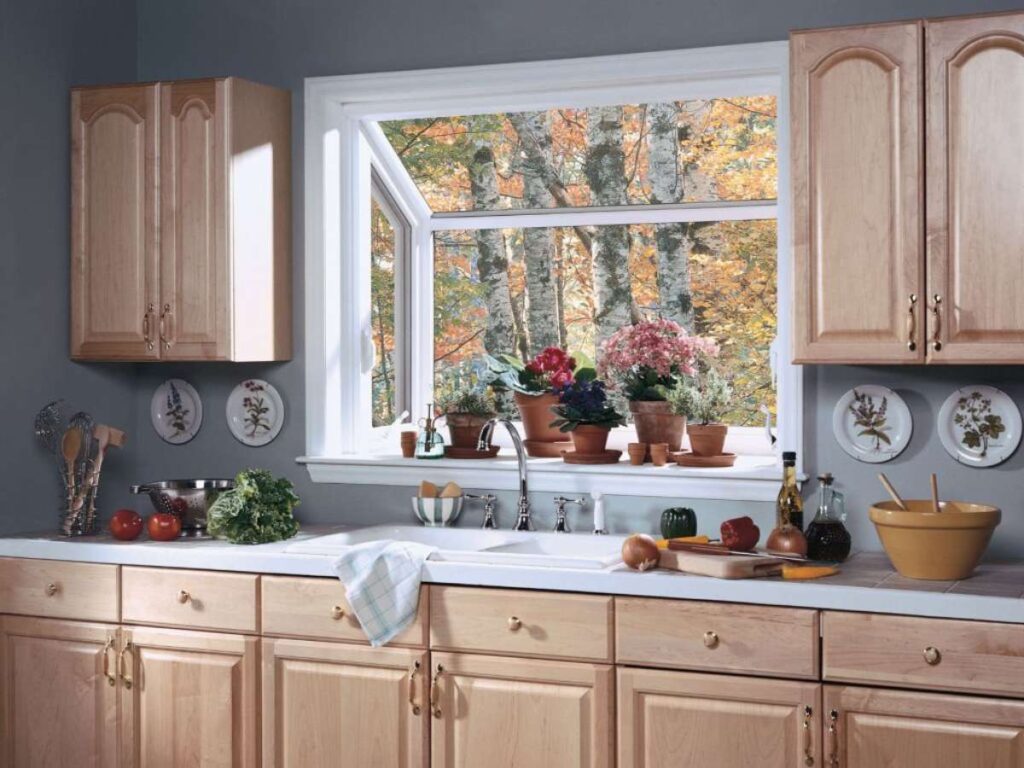
3. Sink-Centered Bay Windows
A sink-centered bay window is one of those design choices that makes a kitchen feel more open without actually adding extra square footage. It transforms the space above your sink from just a wall into something functional and inviting. You get more light, fresh air, and a nice view right where you spend a lot of your time each day.
Washing dishes or prepping meals becomes more enjoyable when you can look out the window, even if it’s just a glimpse of your backyard. That simple shift replacing a flat window with a bay can change the whole vibe of the kitchen.
General Layout and Placement
- Above the Kitchen Sink: The window sits directly above the sink and countertop, gently pushing outward to give you a little extra space.
- Angled or Box Frame: Most sink-centered bays use angled sides to maximize light. But if you prefer clean lines, a box frame works well too.
- Between Cabinets: In many layouts, the bay fits nicely between two upper cabinets, acting as a visual break and making the wall feel less heavy.
- Facing an Exterior View: These windows are best placed where you can see something relaxing—a garden, patio, or even just an open space. Even a simple backyard feels peaceful from this spot.
Main Function and Benefits
- Improved Light: With three glass panels instead of one, your sink area gets much brighter. This is especially helpful for kitchens that face north or don’t get much sun.
- Better Ventilation: If you add casement windows on the sides, you can bring in fresh air while also getting rid of cooking smells without relying on a fan.
- More Comfortable Work Zone: Standing at the sink with a view to look at can make the whole area feel less closed off. It’s a small change that can make your work area feel lighter and more relaxed.
- Visual Expansion: The bay window creates the illusion of more space, even in small kitchens. It’s a simple trick to make the room feel open.
Recommended Kitchen Types
- Galley Kitchens: If space is tight, this is a great way to add depth without changing your layout. A bay window makes the space feel bigger and airier.
- Compact Rental Kitchens: In short-term rental kitchens, a bay window adds light and charm. It’s a feature that sets your space apart and gives guests something extra to enjoy.
- Villas with Garden Views: These kitchens, often with rear-facing sinks, can really benefit from a bay window. It brings the outside in, making space feel more connected to nature.
- Traditional or Farmhouse Layouts: If your kitchen has a more rustic or vintage vibe, a bay window with wood frames or classic grids can complete the look, especially if paired with an apron sink.
Design Features to Consider
- Stone or Tile Sill: A durable sill beneath the window resists water damage and gives you a spot to place plants or dish soap.
- Window Grids or No Grids: If you want a more modern look, clear panes are great. But if your kitchen has a traditional feel, adding window grids can tie everything together.
- Casement or Awning Panels: These side windows open outward, letting in fresh air without letting rain in. They’re simple to use and great for ventilation.
- Matching Trim and Paint: Keep the window trim aligned with nearby cabinets. Matching the colors will help the bay window blend in smoothly with the rest of the kitchen.
Installation Tips and Precautions
- Check Counter Depth: Before you install, make sure the bay window doesn’t interfere with your faucet or backsplash. Measuring carefully will prevent any design headaches later.
- Support Bracing: Even small bay windows need proper support. It’s a good idea to consult with a builder about the right frame setup and header for stability.
- Protect Against Moisture: Caulking or flashing around the window’s base will help prevent water damage from splashes or weather, making sure your investment lasts longer.
- Mind the Outside Clearance: Take a look at what’s outside the window before installation. You’ll need enough room for the window’s projection to fit safely.
A sink-centered bay window can bring in more light and make everyday tasks less stressful. It’s a simple upgrade that has a big impact on how your kitchen feels and functions. Whether you’re working on a home kitchen, villa, or rental property, a bay window can help create a space you enjoy spending time in.
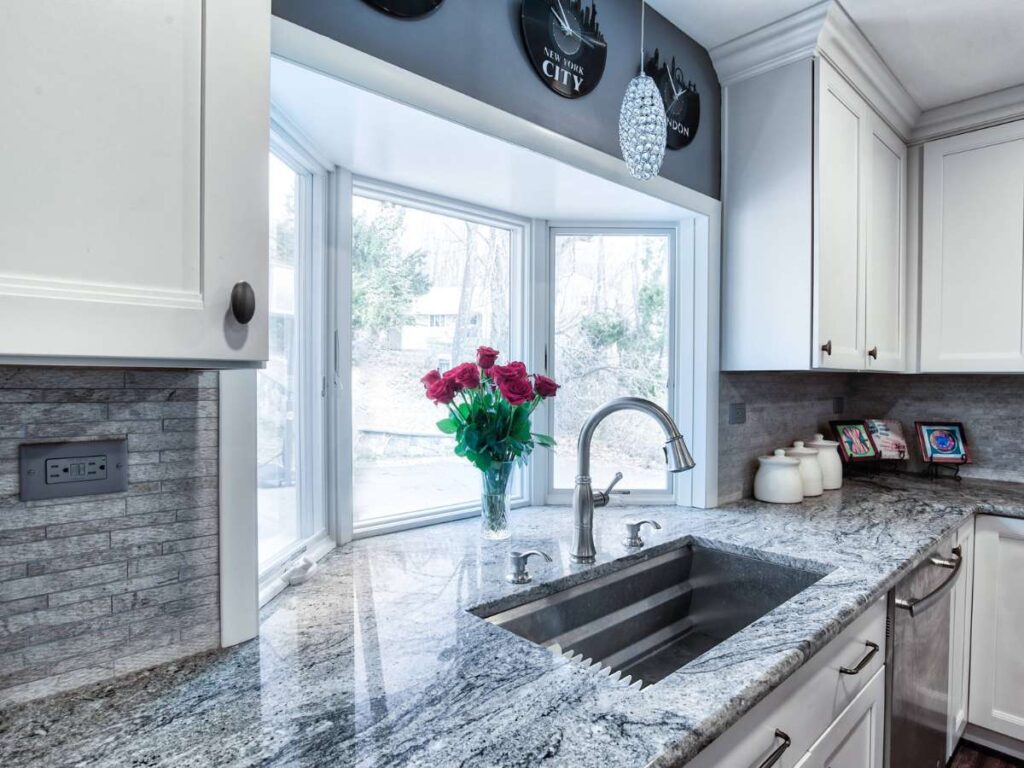
4. Counter Extension Bay Windows
A counter extension bay window is a smart way to add more workspace without changing your kitchen’s layout. It creates a bump-out at counter level, which brings in extra light and adds space at the same time. This design is ideal if your kitchen feels cramped, but you’re not quite ready for a full remodel.
The added surface area can be used for food prep, displaying items, or even as a small serving shelf if the window faces an outdoor patio. It’s flexible, practical, and makes the kitchen feel less boxed in.
Here’s how you can use it in your space:
General Layout and Placement
- Level with the Countertop: This bay window lines up with your existing counter height. The extension pushes outward, giving you more surface area inside the kitchen.
- Box or Deep-Angled Frame: Most counter extension bay windows are square or lightly angled to hold weight. The depth is typically greater than a standard bay, making it more functional.
- Open or Framed Above: You can choose to leave the space open all the way to the ceiling, or build a small soffit above. Some designs also extend the backsplash around the inside of the bay for a more polished look.
- Facing a Patio or Outdoor Area: Positioning this bay window above lower cabinets that face an outdoor space makes it much more functional. It’s a great fit near seating areas or serving points.
Main Function and Benefits
- Added Work Surface: This type of bay window gives you extra room for meal prep or staging dishes, which is especially helpful in kitchens that don’t have an island or peninsula.
- Pass-Through Option: If the window is near a patio or deck, it can serve as a serving ledge, making outdoor dining easier and connecting the kitchen to the outside.
- More Storage Below: Some homeowners even build custom cabinets or drawers under the extended counter. This creates extra storage for kitchen tools or small appliances.
- Framed Outdoor View: The outward projection of the bay adds dimension to the wall and brings more natural light into the kitchen. It’s a great way to tie the outdoors into the indoor space.
Recommended Kitchen Types
- Straight Wall Kitchens: This layout works well for kitchens with a single wall or galley design. The extension adds depth without blocking walkways or appliances.
- Villas with Outdoor Access: Many villas have kitchens that open to a yard or terrace. A counter extension bay window helps blend the indoor and outdoor spaces seamlessly.
- B&B Kitchens with Shared Serving Zones: For bed-and-breakfasts where staff need to pass dishes to guests, this layout makes it easier and more casual. It provides a link between the kitchen and dining area.
- Small Urban Kitchens: In tight spaces, every inch counts. A counter extension adds functionality without taking up more room, which is perfect for small kitchens.
Design Features to Consider
- Sturdy Countertop Material: Choose a countertop material like stone, quartz, or composite that matches your existing counters. These materials handle temperature changes and wear them over time.
- Low Window Sill or Full Glass Panel: Some designs bring the glass right down to the counter, while others leave a short backsplash ledge for extra protection.
- Hidden Power Outlet: Consider adding a pop-up outlet so you can use the counter space for small appliances. It keeps the area clean when not in use and still offers convenience when you need it.
- Drop-Down Shade or Blind: If sunlight is intense, a simple pull-down shade can help protect your counter from damage. It also keeps things looking tidy when you want to hide any clutter.
Installation Tips and Precautions
- Check Structural Load: Because countertops are heavy, your bay window needs proper support. Brackets or braces underneath the counter may be required.
- Waterproof the Edges: Make sure to seal all seams along the window sill and backsplash to prevent leaks from spills or rain.
- Plan for Ventilation: If the window doesn’t open, be mindful of airflow in the kitchen. If it does open, ensure it clears the counter edge safely.
- Consider Outside Viewpoints: Remember, the bay will be visible from the outside. Match the trim and angles to your home’s exterior design for a cohesive look.
A counter extension bay window adds real function to your kitchen where it’s needed most right in the workflow. It’s a change that’s both practical and stylish, helping you make the most of your space. Plus, it works inside and out, creating a stronger connection to the outdoors.
Final Tips for Bay Windows in Kitchens
Choosing a bay window isn’t just about design. It’s about making your kitchen work better more light, more function, and less wasted space. Whether you’re planning a new build or updating an older layout, the key is making sure the window fits smoothly into your kitchen’s daily flow.
Here are a few things to keep in mind before you move forward:
- Window Direction: East-facing bays bring in soft morning light, making them perfect for a bright start to the day. South or west-facing windows may need shading to avoid extra heat in the afternoon sun.
- Glass Selection: Insulated or double-pane glass helps regulate the temperature inside your kitchen. This is particularly helpful if you live in warmer or more humid climates.
- Airflow Options: Consider adding a window panel that opens, even slightly. Fresh air can make the space feel more comfortable, especially when the weather gets warmer.
- Durable Framing: Kitchens are high-use, high-moisture areas. For long-lasting results, choose framing materials like aluminum or uPVC instead of bare wood.
- Outdoor Clearance: Make sure there’s enough space outside for the window’s projection. Check for fences, trees, or roof edges that might block the window’s path.
- Wall Strength: Even a shallow bay window adds weight. A contractor can check if your walls are ready to support the new addition.
A well-installed bay window doesn’t demand attention it just works. When it’s made with materials that are durable and fit your space, like those offered by Vallisco, it becomes an integral part of the kitchen. Quietly adding value every day.
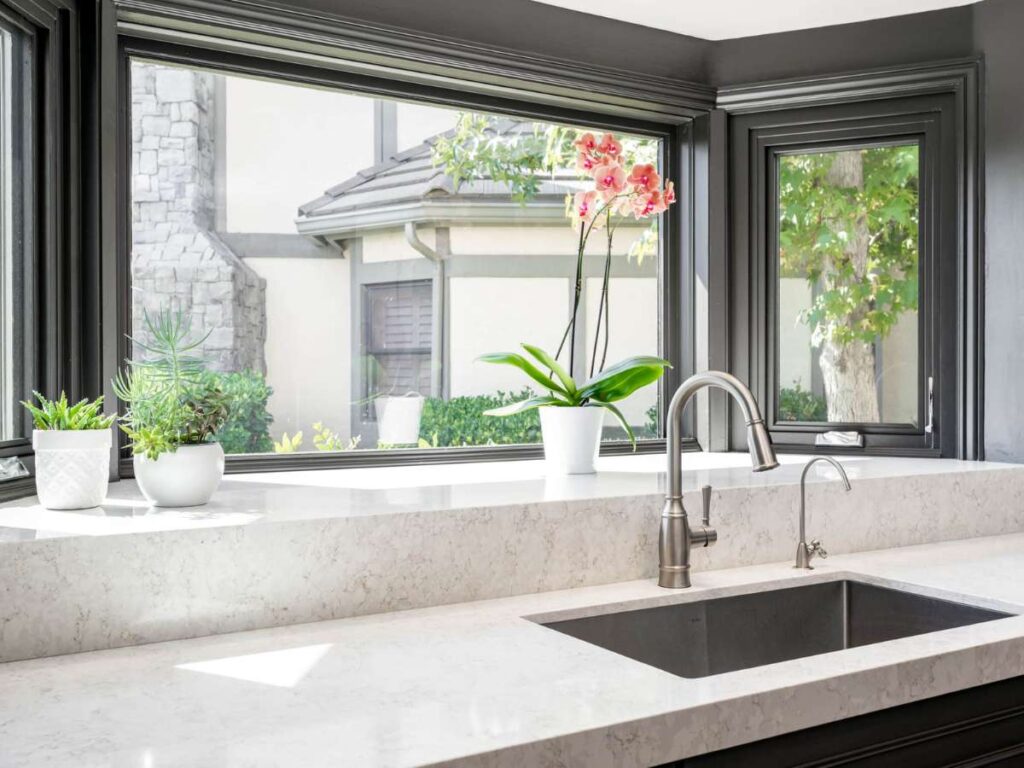
Conclusion
Your kitchen doesn’t have to feel dark, boxed-in, or bland.
Just like those homeowners I spoke with the ones who kept saying “something feels off” you can shift the feel of your space without rebuilding everything.
A bay window brings in light, air, and life. Whether you want a seat, a shelf, or a view, there’s a design that fits.
Now you’ve got four ideas, real examples, and practical tips. So, which one fits your kitchen best?
Ready to take that next step?
Let’s talk about what would work in your space contact Vallisco today.
Recommended Reads for You
Interested in more? Here are some additional articles with insights and tips to keep you informed:
Still haven’t found what you’re looking for? Don’t hesitate to contact us. We’re available around the clock to assist you.





